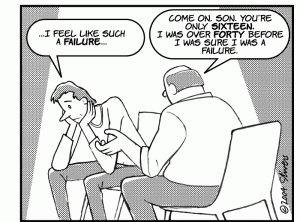inspired to fail — part 2 of 3
It might seem ironic that the venerable Harvard Business Review, a publication from an institution that has produced many successful leaders, would devote an entire issue to failure as it did last month. But given how much research and work has been done on the subject, it turned out to be one of the best issues of the journal I’ve read in a long time.
This is the second in a three-part mini-series based on HBR’s Failure Issue. Yesterday I outlined what the publication covered in terms of the importance of self-awareness and assessment when it comes to failure.
Today I outline the takeaways about others. The issue made it clear – when it comes to working with others, the best approach to failure involves setting expectations and having empathy.
Failure is an inevitable part of business. So one of the most important responsibilities leaders have is to shape how their organizations deal with it.
In the issue’s focal piece, HBS prof Amy C. Edmondson advocated that leaders must build an environment where people feel safe to help spot existing and pending failures and to learn from them. One critical practice in doing so is framing the work accurately.
People need a shared understanding of the kinds of failures that are to be expected and why openness and collaboration are important for surfacing and learning from them. “Accurate framing detoxifies failure,” Edmundson wrote.
Setting boundaries is another important way to build a psychologically safe environment. Leaders need to be clear about what acts are blameworthy and what the consequences will be. There’s freedom in boundaries.
Another HBR piece built on this idea by outlining how important it is for leaders to be clear about where failure will be tolerated and where it won’t. Mike Eskew, the former CEO of UPS, did so for his organization by putting the customer experience out of bounds for failure: they don’t experiment with moving, paying for, or otherwise interacting with a package. Entrepreneurial experiments are encouraged in all other areas of their business.
A UK-based global retailer formalized rules for when failure is acceptable, including when:
- The effort involves genuine uncertainty.
- It’s riskier to do nothing – or to conduct further analysis – than to act and fail.
- The major underlying assumptions are documented in writing.
- Commitments are scaled according to our increasing understanding.
- We’ve defined what success would look like – and the opportunity is significant.
Building the right organizational culture is also important. HBR reported the U.S. Army believes managers can change the culture of their organizations to focus on the positive instead of the negative, and in doing so, turn pessimism and helplessness into optimism and can-do actions. So the Army’s Master Resilience Training includes practical instruction on positive communication, like effective praise (the more specific, the better) and assertive communication (differentiating it from passive or aggressive).
Rosabeth Moss Kanter offered another perspective on culture, writing, “Self-confidence, combined with confidence in one another and in the organization, motivates winners to make the extra push that can provide the margin of victory. The lesson for leaders is clear: Build the cornerstones of confidence – accountability, collaboration, and initiative – when times are good…maintain a culture of confidence as insurance against the inevitable downturns.”
Finally, leaders need to cultivate others-awareness. One article explained, “Whereas self-awareness helps you understand what messages you’re sending, political awareness helps you understand what messages others are receiving.” It’s just as important.
You must know your audience and recognize that each situation is different. So you must find the right way to approach failure when working with different people.
The self-assessment tools I outlined in yesterday’s post are applicable to developing understanding of and empathy for others. Having insight into others’ motivational biases and emotional reactions to failure can help you move toward more open, adaptive responses. And you can give people feedback in the right way and at the right time – feedback that increases their self-awareness and political awareness and ultimate helps them change their ways.
When it comes to managing yourself and others, the common thread through the HBR Failure Issue is that leaders need to open themselves up. They need to be open to new ways of thinking, acting, and leading. Perhaps the most challenging is to be open-minded about the value of failure and to actively pursue it.
In the last post of this mini-series, I relay how deliberate, designed failure may be one of the most valuable contributions a leader can make.